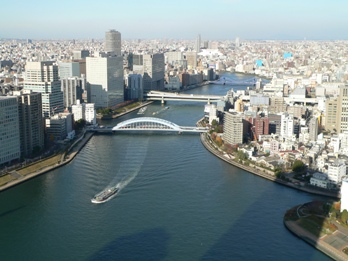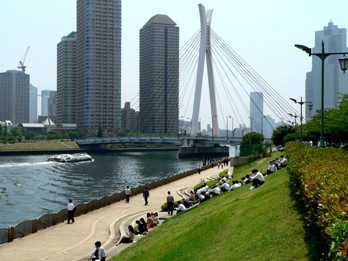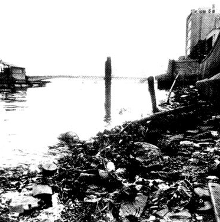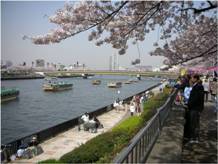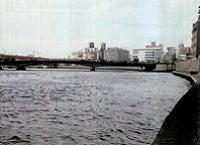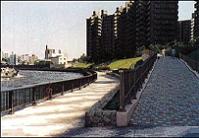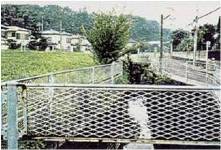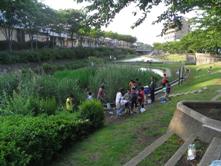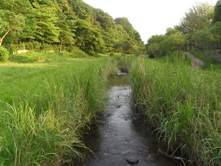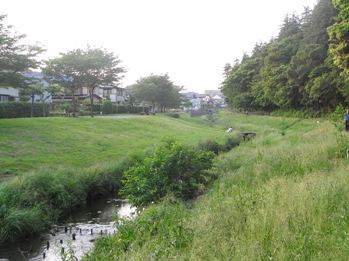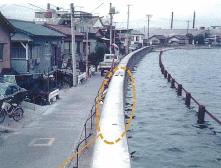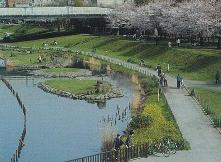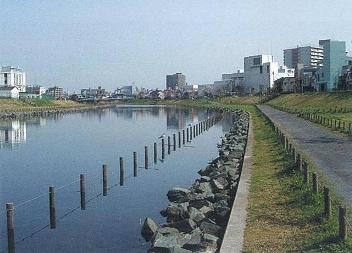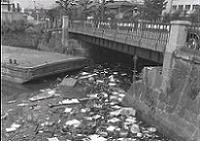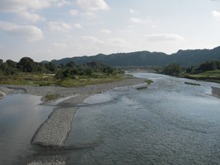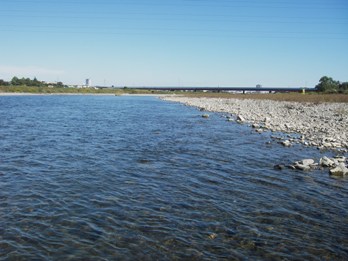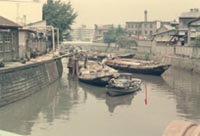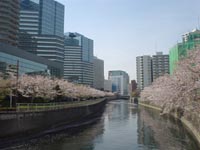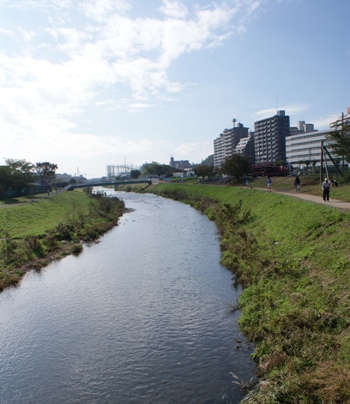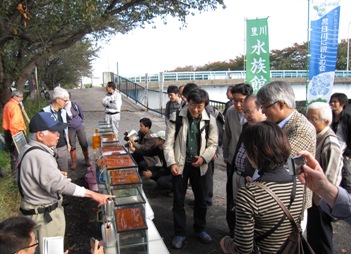
< World's WATERFRONT:JAPAN Category: Kanto >
|
Current condition (Source: source: Tokyo Metropolitan Gov.)
|
Sumida River around 1967
(source: Tokyo Metropolitan Gov.)
|
|
Current condition
(source: Tokyo Metropolitan Gov.)
|
Before
(source: Tokyo Metropolitan Gov.)
|
|
After
(source: Tokyo Metropolitan Gov.)
|
Postwar Sumida River waterfront was occupied by factories and warehouses, was deteriorated like a ditch, and was shunned by people. At the same time, industrial and logistical structure changes sap the area’s vitality as a production base. But increasing interest in environment headed for the semi-ruined city waterfront and a possibility of its restoration emerged and city-and-river development started, thus attractive urban area was gradually created.
The water quality of Sumida river was remarkably low in 1950s because of the industrial/domestic wastewater generated from rapid industry development and urbanization. However, after the Olympics held in Tokyo in 1964, the water quality was significantly improved by popularization of sewage water treatment system and more stricted restrictions.
Sumida river is characterized by 1) general river slope which promotes stagnant area 2) large effect of sea water that goes upstream 3) 60% of river water is treated sewage water. Therefore, efforts are being made to improve the water quality by modifying sewer system and introducing advanced waste water treatment.
In Asian nations with worsening river environments, Sumida River, improving after experiencing 50-year deterioration is a leading example in Asia.
>>More details, “River Rehabilitation with a focus on the Sumida River”(ARRN 4th International Forum held in 2007)
>>More details (PDF 50KB)
By JRRN-secre | Category: Community and urban river restoration,Kanto | Comment(0) | Trackback(0) |
Date: 2012.03.31 18:34
|
Before Restoration Project
|
|
Photo by Michiya Tannai, May 2008
|
Izumi River flowing north and south longitudinally in Seya and Izumi Wards of Yokohama City is positioned as an important river in Yokohama’s river environment improvement project called the “Community River Improvement project.”
In the first half of the ’90s, basic research related to animals and plants in watershed areas of Izumi River was conducted for preparation of river restoration and scenery and a land utilization program was launched while preserving biological resources.
Today, Izumi River attracts a great deal of attention from people engaged in river restoration work as a good case example of reproducing diversity of the river from the viewpoint of the waterfront ecological system and landscape and river utilization by citizens although it is an urban river. In 2005, this project won the highest design award of the Japan Society of Civil Engineers’ Design Prize.
By JRRN-secre | Category: Community and urban river restoration,Kanto | Comment(0) | Trackback(0) |
Date: 2012.03.30 16:19
|
Before restoration (1960’s)
|
|
After restoration
|
After restoration
Source: Sep. 2006 Tokyo Metoropolitan Govt.
|
In watershed areas of the Old Naka River, because the surrounding ground is low, a river development project has been conducted to lower the water level to prevent flooding. Together with this project, highly water-attracting, beautiful waterfront spaces have been regenerated without damaging the river environment.
By JRRN-secre | Category: Community and urban river restoration,Kanto | Comment(0) | Trackback(0) |
Date: 2012.01.05 16:13
Before(1970s)
(source: Tokyo Metropolitan Gov.)
|
|
After
(source: Keihin Office of River)
|
Tama River, with Ogouchi Dam (called Okutama Lake), completed in 1957, and with tourist facilities, has been a relaxation and recreation area for Tokyoites. But its midstream and downstream in Tokyo and Kanagawa have been urbanized as residential and industrial areas. During the high-growth period in 1965-75, its water quality was deteriorated and the variety of the water usage increased. Residents gradually needed more orderly space usage.
Recently natural life has returned to the area as the sewage system penetrated and the water quality improved.
>>More details (PDF 109KB)
By JRRN-secre | Category: Nature oriented restoration,Kanto | Comment(0) | Trackback(0) |
Date: 2012.01.05 16:13
Before restoration (1972)
Source: Tokyo Metoropolitan Govt.
|
|
After restoration (2008)
Photo by Akira Wada, Aug. 2008
|
In watershed areas of Meguro River flowing through Tokyo, urbanization has been promoted since the Meiji Period, and the water quality was extremely deteriorated in the high-growth period. Then, bubbles of detergent floated on the water surface and unpleasant odors were produced over a long period. Later, the water quality and scenery were dramatically improved through the introduction of sewage systems and local citizens’ efforts.
However, there are many combined sewer systems in the watershed area of Meguro River even today, and there are some problems such as the river giving off a bad odor at times of flooding. Currently, various approaches aiming at water environment improvement such as releasing reclaimed sewage water and water purification experiments by using highly concentrated oxygen dissolution water are being conducted to restore the watershed areas where people can enjoy cherry-blossom viewing.
By JRRN-secre | Category: Community and urban river restoration,Kanto | Comment(0) | Trackback(0) |
Date: 2012.01.05 16:13
|
Movable aquarium by local citizen group
|
In the high-growth period, human sewage was fed into this river and the water quality was extremely deteriorated. In recent years, however, due to river improvement balancing flood control and environmental preservation with specific efforts for collaboration between citizens and administration in addition to improvement of the surrounding sewer network, the water quality and river environment has been improved greatly.
In the downstream area of Saitama Prefecture, this area is used as a water-attracting park because the bank protection work is small scale and the water-attracting qualities are high. In particular, in the downstream area in the north of Niiza City, many people enjoy fishing and the tranquil Musashino landscape is preserved as there is no residential area. In the upstream site of Higashikurume City, Tokyo, a cycling road has been built on either bank, where many people enjoy walking.
The Kurome River was awarded grand prix in the 5th “Iikawa & Iikawa-zukuri” workshop (old name: River’s day workshop in Japan) in Sep. 2012.
By JRRN-secre | Category: Community and urban river restoration,Kanto | Comment(0) | Trackback(0) |
Date: 2012.01.05 16:12
Uzuma River was so contaminated that it was named the second-most contaminated river in Japan.
However, the clear stream was recovered through water quality improvement measures and the adoption of the Hometown River Model Project. Also a comfortable water environment and living climate has been regenerated, where transportation by ship has restarted and 100,000 carps swim. In this way, local regeneration rooted in history and culture has been realized.
Today, Uzuma River is evaluated as a tourist spot with the historical landscape of Tochigi city, designated as one of the 100 best city landscapes in Japan. It also won the "Public Color Award - 10 environmental colors" in 2003 and the grand prize of the "Handmade Hometown Award" in 2005.
By JRRN-secre | Category: History and traditional restoration,Navigation restoration,Kanto | Comment(0) | Trackback(0) |
Date: 2011.09.10 18:46
Tamagawa Waterworks is a canal approx. 43km in length from Hamura City, Tokyo to Yotsuyaokido, Shinjuku Ward, excavated by the government of Edo to relieve water shortages in Edo by taking water from Hamura Diversion Weir of Tama River. Today, the part from Hamura Diversion Weir to Kodaira Observation Point approximately 12km in length is actually used.
Tamagawa Waterworks is a long wooden structure built based on the excellent surveying technology of early modern ages. It was designated as one of the Japanese historical places in August 2003 because it is a valuable civil engineering heritage as the water supplying facilities for a large city of Edo and irrigation water for Musashino highland in modern times.
By JRRN-secre | Category: History and traditional restoration,Kanto | Comment(0) | Trackback(0) |
Date: 2011.09.10 18:32
Since the beginning of the Edo Period, ships have sailed Shingasi River transporting people and goods and it also served the cultural role of connecting Kawagoe and Edo closely. However, such a role was weakened along with the opening of the railways. Also the volume of the river water became insufficient due to river improvement work for flood prevention. Thus, transportation by ship was discontinued in the beginning of the Showa Period.
Today, there is an attempt to revive transportation by ship on Shingasi River to promote tourism, and a social experiment of transportation by ship for tourists is being conducted in the water area near streets with the atmosphere of Edo in central Kawagoe City.
By JRRN-secre | Category: Navigation restoration,Kanto | Comment(0) | Trackback(0) |
Date: 2011.09.10 18:28
Itako City, together with Sahara City located in the south of Tone River, flourished as a transshipping port to convey products of each clan of Oshu to Edo.
Today we can enjoy attractive scenery unique to a "riverside district" as a tourist town typified by small ships coming and going on the water and boatwomen.
Itako boating station with a 2,000m course using the straight river area is highly evaluated as a waterfront for social interaction. It won the "Handmade Hometown Award" in 1986.
By JRRN-secre | Category: Navigation restoration,Kanto | Comment(0) | Trackback(0) |
Date: 2011.09.10 18:27
| Next >>
